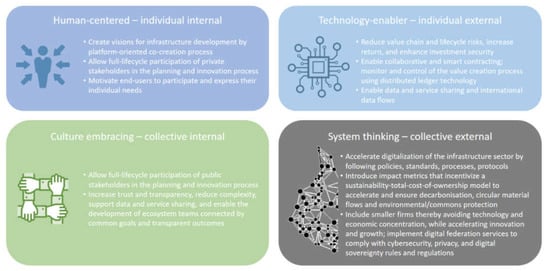2. Outcome of the Expert Interviews, Workshops, and Literature Assessment
There is an industry-wide consensus that driving best practices in infrastructure planning and delivery includes:
-
A well-articulated vision for infrastructure that enables a systematic development of a robust pipeline of bankable projects and long-term plans with robust business cases;
-
Strong project governance arrangements to enable strong project delivery including a more agile set of regulations to reflect optimal practice embracing new infrastructure technologies;
-
The careful management of societal and environmental impacts to support project delivery. An early and thorough multi-stakeholder participation minimizes risks and maximizes positive overall outcome. Risk transfer needs to be carried out appropriately to maintain value for money;
-
A procurement model chosen on the basis of project specifics and rigorously following established published guidelines.
However, this very condensed evaluation is not surprising. The common infrastructure problems are well known globally and are frequently analyzed and evaluated. However, in many cases the question arises as to why governments and institutions do not simply implement leading practices and state-of-practice recommendations. The authors of this article and the key contributors to the article listed below have studied this question in depth and have developed the following hypothesis:
As the process of infrastructure development and delivery is very complex, the best practice approach is to decompose the overall task into smaller components which are understandable and manageable. This approach is a basic principle in our economy based on division of labor. The process of infrastructure development and delivery in most countries is, therefore, a stepwise phase process, where the next phase begins as soon as the preceding phase is closed
[25]. The level of granularity of planning increases with each phase until it is brought to a constructible planning state. Such linear consecutive processes are called “waterfall model”
[26].
Each phase is executed independently and has its particular composition of stakeholders. Often, project leadership also changes across different phases. The process is so segregated that a common understanding of the entire process does not exist among the majority of relevant stakeholders, and the process itself regularly loses sight of the desired outcomes. As a result, problems in the process are usually addressed in a specific phase or even within a sub-phase, while the entire process model is hardly questioned. This approach is seen as a common way of avoiding change.
Consequently, such complex multi-stakeholder processes tend to lead to a multi-dimensional principal-agent dilemma in which asymmetric information policies predominantly increases local efficiencies in the functional silos of the project. However, the optimization of the benefits of the overall system, or even more, the interests, needs, and requirements of the infrastructure asset users move entirely out of sight.
To understand the root causes, problems must first be addressed and related to the specific phase or component of infrastructure development and delivery. As mentioned earlier, the problems existing at this granular level are well known. This approach is necessary, but not sufficient; it is not sufficient since the overall problem of asymmetric information cannot be solved at the specific level of granularity. Moreover, the problem of slow planning processes or administrative hurdles will not be solved simply by accelerating the planning processes nor merely by reducing administrative hurdles. Instead, a system change is needed that allows for a holistic solution that can simultaneously address the four perspectives explained in
Section 1.2.
In other industry sectors, we see that value creation evolves through trusted networks of collaboration, so-called value networks
[27]. The underlying multistakeholder and multidisciplinary ecosystems increasingly become the backbone of our digitalized world, mobilizing specialized actors that share values, governance principles and common goals. Value networks are interactive, integrative and agile, and focus on people’s needs. In infrastructure development and delivery, however, such value chain integration is lacking
[8] and very important to achieve usability and sustainable goals.
We can conclude that the global infrastructure gap
[28] and the need to develop sustainable infrastructure cannot be eliminated by taking only the financial aspects into account; the whole value chain of development and delivery has to be transformed into an integrated system, a value network, focused on end user needs but also on social requirements, as well as a much broader approach to value creation. The root cause is the existing fragmentation and lack of cooperation within the infrastructure value chain. Sequential (waterfall) planning and resource-efficiency (focusing on silos) are still common practice, compared to the necessary flow-efficiency and agility (across the value network), preventing a more impactful realization of broader goals.
Therefore, a holistic approach (Figure 1) of development and delivery of sustainable infrastructure is needed to integrate the value chain in this important economic sector. By focusing on the traditional “waterfall model,” such integration cannot be achieved.
Figure 1. Holistic perspectives on infrastructure development.


